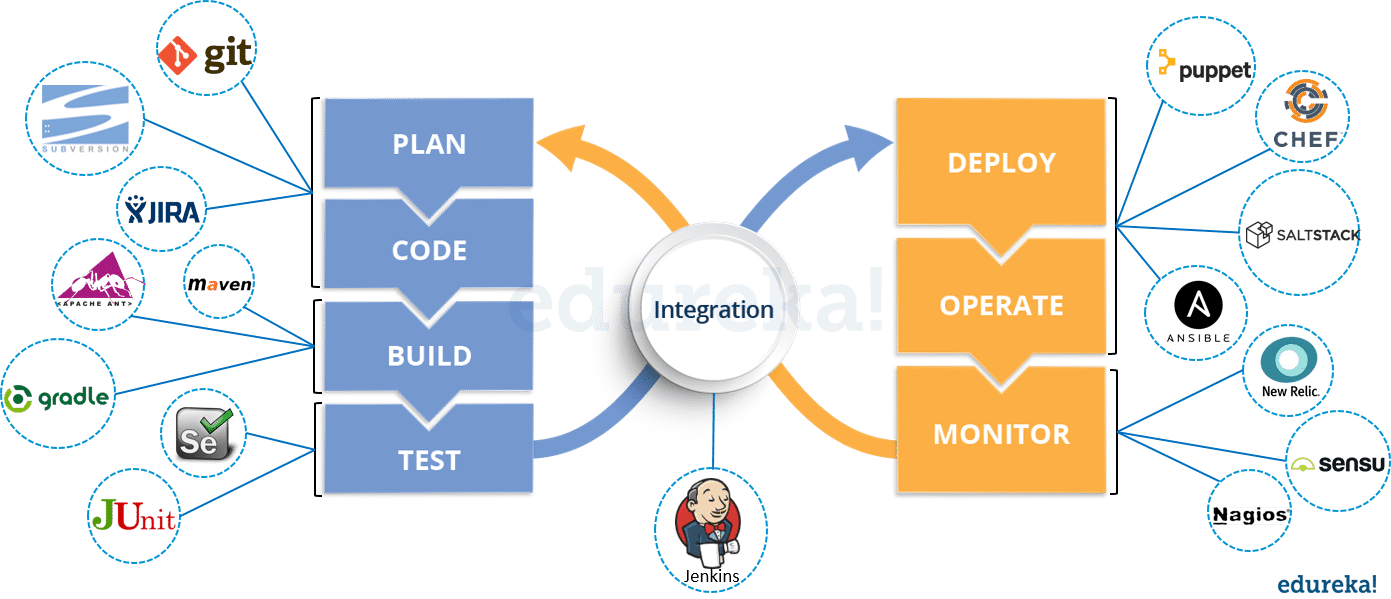What are the fundamental differences between DevOps & Agile?
The differences between the two are listed down in the table below.
| Features | DevOps | Agile |
|---|---|---|
| Agility | Agility in both Development & Operations | Agility in only Development |
| Processes/ Practices | Involves processes such as CI, CD, CT, etc. | Involves practices such as Agile Scrum, Agile Kanban, etc. |
| Key Focus Area | Timeliness & quality have equal priority | Timeliness is the main priority |
| Release Cycles/ Development Sprints | Smaller release cycles with immediate feedback | Smaller release cycles |
| Source of Feedback | Feedback is from self (Monitoring tools) | Feedback is from customers |
| Scope of Work | Agility & need for Automation | Agility only |
Q2. What is the need for DevOps?
According to me, this answer should start by explaining the general market trend. Instead of releasing big sets of features, companies are trying to see if small features can be transported to their customers through a series of release trains. This has many advantages like quick feedback from customers, better quality of software etc. which in turn leads to high customer satisfaction. To achieve this, companies are required to:
- Increase deployment frequency
- Lower failure rate of new releases
- Shortened lead time between fixes
- Faster mean time to recovery in the event of new release crashing
DevOps fulfills all these requirements and helps in achieving seamless software delivery. You can give examples of companies like Etsy, Google and Amazon which have adopted DevOps to achieve levels of performance that were unthinkable even five years ago. They are doing tens, hundreds or even thousands of code deployments per day while delivering world class stability, reliability and security.
If I have to test your knowledge on DevOps, you should know the difference between Agile and DevOps. The next question is directed towards that.
DevOps Certification Training
Q3. How is DevOps different from Agile / SDLC?
I would advise you to go with the below explanation:
Agile is a set of values and principles about how to produce i.e. develop software. Example: if you have some ideas and you want to turn those ideas into working software, you can use the Agile values and principles as a way to do that. But, that software might only be working on a developer’s laptop or in a test environment. You want a way to quickly, easily and repeatably move that software into production infrastructure, in a safe and simple way. To do that you need DevOps tools and techniques.
You can summarize by saying Agile software development methodology focuses on the development of software but DevOps on the other hand is responsible for development as well as deployment of the software in the safest and most reliable way possible. Here’s a blog that will give you more information on the evolution of DevOps.
Now remember, you have included DevOps tools in your previous answer so be prepared to answer some questions related to that.
Q4. Which are the top DevOps tools? Which tools have you worked on?
The most popular DevOps tools are mentioned below:
- Git : Version Control System tool
- Jenkins : Continuous Integration tool
- Selenium : Continuous Testing tool
- Puppet, Chef, Ansible : Configuration Management and Deployment tools
- Nagios : Continuous Monitoring tool
- Docker : Containerization tool
You can also mention any other tool if you want, but make sure you include the above tools in your answer.
The second part of the answer has two possibilities:
The second part of the answer has two possibilities:
- If you have experience with all the above tools then you can say that I have worked on all these tools for developing good quality software and deploying those softwares easily, frequently, and reliably.
- If you have experience only with some of the above tools then mention those tools and say that I have specialization in these tools and have an overview about the rest of the tools.
Q5. How do all these tools work together?
Given below is a generic logical flow where everything gets automated for seamless delivery. However, this flow may vary from organization to organization as per the requirement.
- Developers develop the code and this source code is managed by Version Control System tools like Git etc.
- Developers send this code to the Git repository and any changes made in the code is committed to this Repository.
- Jenkins pulls this code from the repository using the Git plugin and build it using tools like Ant or Maven.
- Configuration management tools like puppet deploys & provisions testing environment and then Jenkins releases this code on the test environment on which testing is done using tools like selenium.
- Once the code is tested, Jenkins send it for deployment on the production server (even production server is provisioned & maintained by tools like puppet).
- After deployment It is continuously monitored by tools like Nagios.
- Docker containers provides testing environment to test the build features.




0 Comments
Post a Comment